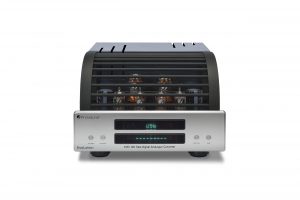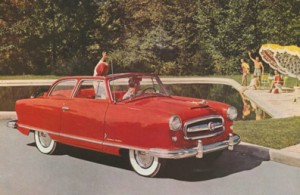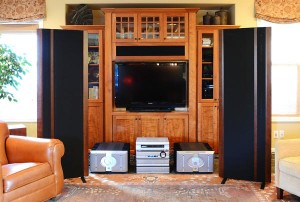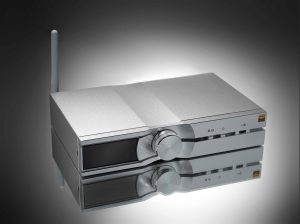Language is a very imprecise tool. But also thanks to it the evolution of apes resulted in an Aristotle, Michelangelo and Fangor. Still, however, we struggle with ambiguities, gaps, misunderstandings. Often, we ourselves are to blame, because the economics of language causes simplification of a lot of things, eliminating what is not commonly used, similar to something else, etc.
Such, for example, "DAC", as used in the name totaldac, on one hand, we know what it is, if only we have anything to do with audio, on the other... DAC stands for "Digital to Analog Converter". However, it actually has two meanings: it's a means to convert digital signal to its analog form, usually a small chip, and the second meaning is the whole device used to convert digital signal to analog one of which this small chip is the main component. Hence we are talking about two different things here.
DAC for a common man
DAC which is an element (chip) converting digital signal to analog and it is a part of the device that converts digital signal to analog. But in order to being able to convert signal and make it useful for the audio system, "DAC" has to be surrounded/supported with other circuits and components. Typically, in the input stage there is a digital receiver. Almost always it is a chip of one of the specialized brands, such as: Burr Brown, AKM, Analog Devices. Sometimes a programmable DSP is used instead with its own software written by the DAC's manufacturer. The receiver works as sort of "interpreter" of the input signal for the DAC chip. If the device features USB input it is followed by a specialized receiver that converts USB signal to PCM, which is "understandable" for the D/A converter.
Often, especially in recent times, between the receiver and the converter one places digital filters, for example, upsampler ("Sample Rate Converter") that converts 16-bit words to 24-bit (this is how the K2 used by Reymio works, as well as the Advanced al32 by Denon), or to DSD signal, or, finally, a DSP with implemented filters.
DAC is also almost always a chip from one of the above listed expert manufacturers, that was joined few years back by the current leader of the market, the ESS Technology with their SABRE32 DAC. This is an eight-channel system, ready for use in multi-channel systems, which can, however, be turned into a stereo one, by combining four parallel channels. This provides a significant reduction in distortion, higher signal-to-noise ratio, etc.; Accuphase, for example, achieves the same using a few, stereo chips.
After signal is converted in DAC it is further processed in the analog domain. First, the current signal is converted to a voltage one, because it's the only kind "understood" by the preamplifiers and power amplifiers. This is called a I/U converter, or a current/voltage one. Usually these are active systems, but sometimes the purist designs feature passive one. And finally there is a gain section and output buffer reducing output impedance. This section is made either by means of integrated circuits, or transistors, or tubes. At the very end of signal's path there are output jacks.
As you can see, the possibilities are plenty, and apart from the said DAC section there are also other elements, such as: oscillators, power supply, enclosure, assembly and so on—a designer must demonstrate creativity, skills, and have his own idea; he can make mistakes in each of the mentioned elements.
d1-single-mk2
d1-single-mk2 is a digital-to-analog converter with variable output (in the digital domain). It is a simplified version of d1-six—instead of three, working in parallel, discrete converters per channel, there is one. This is an unbalanced device and in the XLR output only the "hot" pin is active. But the idea is the same as for the other converters of this brand: instead of a small of-the-shelf chip from an external company, designer uses discrete circuitry, with precise, metalized resistors, switched by integrated circuits. This is so called: R2R DAC. The signal is prepared for it by a programmable DSP, that performs re-clocking and that also features (two) digital filters, including one without oversampling. The user can choose which one suits him best.
The digital signal can be delivered to DAC using one of the four inputs, including the asynchronous USB. All of them accept PCM signal up to 24 bits and 192kHz. Manufacturer offers an optional DSD (DoP) functionality for all inputs at extra cost.
In fact there are even more options available:
- BNC input can replace RCA,
- a massive silver front might be used instead of acrylic one,
- d2-single-mk2 and d3-single-mk2, 69-bit 2 way or 3 way active crossover with RCA analog outputs including a digital preamp for the main volume control and also for the relative level between bass and treble. The crossover slope can be 6dB/oct, 12dB/oct or 18dB/oct. All parameters, crossover frequency, filter slope, relative volume, main volume, relative digital delay... can be controlled from the remote while listening to music.
- bass boost might be added that is useful especially for users of loudspeakers with a single fullrange driver.
One of the things we get as sort of bonus is a headphone amplifier. Headphone output, placed on the rear panel, is suitable for cans of impedance between 32 and 600 Ω; it will provide maximum signal of 3 V.
A few simple words…
VINCENT BRIENT
Designer, owner
WOJCIECH PACUŁA: d1-single-mk2 replaces d1-single?
VINCENT BRIENT: No, it's not like that – it's a completely new converter that now is an entry-level product in our range. It replaces d1-core.
What are the differences between d1-core and d1-single-mk2?
d1-single-mk2 features completely new output stage. It is still a Class-A stage based on transistors but topology has been change resulting in a different sound. I also introduced many other changes in the digital section but these are not as significant as the one in the output. Also headphone output features transistors in Class-A but now its output impedance is lower. So one can use different headphones without a risk or running out of power to drive them.
How do you minimize jitter?
I don't use oscillators working in USB and S/PDIF inputs. I generate a completely new signal using asynchronous process performed by FPGA (FIFO). As a result sound is more natural, without any "metallic signature" of the sound present in a performance of many other D/A Converters.
TOTALDAC in High Fidelity
BEST SOUND 2015 AWARD: totaldac d1-twelve DAC – digital-to-analog converter, see HERE
TEST: totaldac d1-twelve DAC - digital-to-analog converter, see HERE
TEST: totaldac d1-dual DAC - digital-to-analog converter, see HERE
SOUND
Recordings used for the test (a selection):
- Okihiko Sugano Record Collection, Victor Edition/Trio Edition, Audio Meister XRCG-30025-8, 4 x XRCD24 (2012); see HERE
- Andrzej Kurylewicz Quintet, Go Right, Polskie Nagrania "Muza"/Warner Music Poland 4648809, "Polish Jazz vol. 0", Master CD-R (1963/2016); review HERE
- Art Blakey & The Jazz Messengers, The Big Beat, Blue Note/Audio Wave AWMXR-0020, XRCD24 (1960/2013)
- Billie Holiday, Body and Soul, PolyGram/Mobile Fidelity UDCD 658, gold-CD (1957/1996)
- Bob Dylan, Live 1964, Columbia Records/Audio Fidelity AFZ5 230, "Limited Edition No. 0115", 2 x SACD/CD (1964/2016)
- Enya, The Memory of Trees, Warner Music UK/Warner Music [Japan] WPCR-13300, SHM-CD (2009)
- Franc Schubert, 4 Impromptus D899 & D935, perf. Maria João Pires, Deutsche Grammophon/Universal Music Japan UCCG-50095, SHM-CD (1997/2011)
- Janusz Muniak Quartet, Question Mark, Polskie Nagrania "Muza"/Warner Music Poland, "Polish Jazz vol. 54", Master CD-R (1978/2016)
- Pet Shop Boys, Super, Columbia | Sony Music Japan SICX-41, CD (2016)
- Polish Jazz Quartet, Polish Jazz Quartet, Polskie Nagrania "Muza"/Warner Music Poland, "Polish Jazz vol. 3", Master CD-R (1965/2016)
If the quality of high-end device is to be measured by a difficulty in determining its own character, at least initially, the new Vincent's DAC excels. Moving from an integrated CD player Lektor AIR V-edition to the d1-single-mk2, sound character took a different direction. But I had to listen to several tracks to get some idea, that I could later elaborate on and observe. It was easier after replacing a two-box CEC Player (TL0 3.0 + DA 3.0) with totaldac as the differences were more significant. But even after realizing actual differences between these devices, the nature of the French unit was not at all so clear, as it usually is with other devices.
The first sonic feature of the d1-single-mk2 is the transparency. It's this kind of transparency that acts as sort of a "window" giving us better insight to the recording, not impoverishing the sound, but rather enriching it by a very good tonal, dynamics, transients presentation, by rendering a reliable, large soundstage. The second feature is differentiation. At the same time as d1-single-mk2 I also got to review two other fantastic D/A converters, representing different price ranges: Exogal Comet Plus and CEC DA0 3.0. It may not be an objective truth but it is certainly my truth, that among these three totaldac was the most difficult to understand, describe and evaluate.
A differentiation that I mentioned focused mostly on the resolution and tone; dynamics was always high, and the soundstage quite big, mostly deep, not enveloping the listener. How did this differentiation manifest? First of all by precise presentation of all microphone setup's changes, in clearly presented different recording methods, choices made by producers and sound engineers and limitations of both, recording and studio.
For example the Franc Schubert music performed by Maria João Pires on 4 Impromptus D899 & D935 album was actually recorded in two separate session, made at different times, in different places. The first offers a deep, full sound, and was made with close-set microphones. The second is more "dull", although it seems more open; there is more room reverb, which creates an impression of a further distance between listener and instrument. The former was much more convincing to me.
These are not big differences, Deutsche Grammophon engineers tried to make them sound as similar as possible leveling both parts during mastering, or so at least, as I can hear it—their tonality. Still totaldac showed what they are. It didn't infringed track's structures, it was still from the very beginning to the very end a beautiful album, but it worked as it is expected from high-end product—showed the truth about the recording After all mechanically recorded music is a combination of an intent and its implementation. Each of them individual is deficient and only when these two elements come together they form a new quality.
He would be wrong, who based on these few paragraphs would find that it is an unremarkable, clinical, and even "neutral" sounding device. Vincent's converters, including the d1-single-mk2, interpret recordings in a soft, gentle way. They do not add lowest bass notes if these are absent in the recording, they do not wow listener with unnaturally vibrant bells, when it does not make sense. Most of our attention is focused on the middle part of the range. I think it is so mainly due to the best resolution for this part of the range. Plenty of information that is delivered to our ears make up a warm whole. The top and bottom of the range are also a little warm, but to a much lesser extent than the mids, especially its lower part. There works the law of multiplication by cooperating—in this case with the upper bass. This part of the band is powerful, deep and beautiful.
The lowest bass does not appear often in its full glory. With classical music, also with piano, with jazz, it seems that there is exactly as much bass as needed. But when we play something with more power, for example Kendrick Lamaara, we want to have more of even richer bass. The quality of the bass is outstanding, it is not too taut, but the focus and control are great. But then, just as the upper treble, it has a lower energy. This will matter mainly when club music, dub, electronic is played—where it matters musically. Already with the new Pet Shop Boys album Super, there was as much of everything as this music needed. Once again the ability to deliver fantastic midrange including its upper part was confirmed.
d1-single-mk2 as a headphone amplifier
When I was ordering the converter for the review, I was asked by Vincent to specify which headphones would I use. He immediately rejected the HiFiMAN HE-6 due to the very low efficiency, so a natural candidate were so Sennheiser HD800. Knowing that totaldac owner could matched output impedance of the internal amplifier to the impedance of said cans.
Such a setup sounded differently than what I've heard using loudspeakers. The tonal balance shifted up, with a strong emphasis on upper midrange, without the low bass. It was not a bad sound, it was actually very good. First of all due to the extraordinary purity across the whole band and high dynamic range. But the high energy elements playing above 800 Hz were presented more in the front, like a trumpet with a silencer on the Kurylewicz Quintet Go Right album, or snare drum in the "Twenty-something" by Pet Shop Boys.
One of our Readers pointed out to me that I have in my collection also another excellent headphones—AKG K701—so I had to use them too, despite the fact that totaldac was not "prepared" for them. Apparently it is a versatile design, because this combination proved to be the best. It delivered a denser, lower based sound, with more tangible instruments. The spacing was not as spectacular as before, but just in this respect Sennheisers are unique. Everything else improved.
It's a good quality, solid headphone amplifier. It can easily replace separate units that cost 2000-3000 PLN (remember that to that cost one must add a price of a good quality interconnect).
d1-single-mk2 as a preamplifier
My reluctance towards sources with variable output comes from the fact that a separate, high quality preamplifier contributes to the dynamics and richness of the sound, saturates it. There are, of course, systems designed from the start to work without a separate preamplifier. How well they work with devices from other brands is sort of lottery though, so it's hard to call this solution versatile.
Vincent's DAC though sounded great when combined with my Soulution 710 power amplifier. Was it just a coincident that these two devices worked so well together? I don't know, but this power amp usually sound better paired with active preamps. This time, the elimination of the Ayon Spheris III from signal's path resulted in a more direct sound. The leading edge was faster and clearer. The front of the soundstage was brought closer to me and the back even further away, which created the effect of extended soundstage.
Using separate preamplifier gave denser presentation with lower, deeper bass foundation. Vocals with it were delivered with slightly warmer upper part and with tempered sibilant. The dynamics was not, however, higher and bass focus was not as good. Also transparency was not as good as with the direct connection between DAC and power amplifier. Therefore, I'd say one needs no separate preamplifier between d1-single-mk2 and power amp, one will lose a bit but gain much more.
Summary
d1-single-mk2 is an extremely good DAC. It delivers a precise, resolving sound, but also slightly warm and vivid. It is very clean and differentiates recordings really well. It has a tonal balance placed slightly higher than Exogal Comet Plus and CEC DA0 3.0, but still delivers a substantial, rich sound that is simply more open. Headphone amplifier is a nice feature, and the volume control is good enough for one to give up using a separate preamplifier. It's a DAC for all music fans—those who love rock, jazz, and classical music; it does not discriminate against any kind of music.
It does not fall far behind my Lektor AIR V-edition CD Player in terms of sound quality. It is just slightly less detailed, it is also not so expansive and renders a narrower soundstage. In direct connection with a power amplifier it offers faster sound and a better focus in lower midrange and bass. It is also more resolving. This is really something.
DESIGN
d1-single-mk2 is a two-box digital-to-analog converter with integrated headphone amplifier and adjustable (in the digital domain) line output. It features four digital inputs and an unbalanced analog output on RCA and XLR jacks. The digital inputs: AES/EBU, RCA, Toslink and USB—support PCM signal from 16- to 24-bits and up to 192kHz; USB input is asynchronous. One can also order (at extra charge) an option of DSD (DoP) compatibility for all (!) inputs.
Front and rear
The shape of the chassis is characteristic for totaldac, it's sort of a low trapeze. Front is made of black acrylic, but an optional silver aluminum is also available upon request (for additional fee). In the middle sits an amber display, which deliver information on: selected input, the sampling frequency of the input signal and the volume level—in the form of a bar (bar graph) and numerically. There is no information however about headphone output being active.
Manufacturer used sockets of high quality, all are gold plated and really solid. You see also sealed openings—this chassis is used for all totaldac devices, and it is "customized" for a particular model. On the far right side there is a multi-pin socket—one connects there the cable from the power supply, that sits inside the second, much smaller enclosure. That enclosure is made of aluminum, with double walls. At the bottom it features a thick copper plate, that shields the circuits and adds weight to the device.
Inside
The whole converter's circuit is built on two PCB mounted one above the other: the top one is the actual converter, and on the lower one there are power supply and output circuits. The digital signal is received through a matching transformer and goes to the large FIFO chip where it is re-clocked. The user can choose between two digital filters—one of them is without oversampling. Thus prepared, the signal goes to the advance circuit, occupying the entire PCB—is the actual D/A Converter. It is based on discrete resistors—precise metalized resistors from Vishay (0.01% VAR). Two channels consists of 100 such resistors. One can see that only one of the three sections is used—the remaining ones work in d1-six version. The DSP has a graphite plate glued over it and is additionally shielded.

The lower PCB is planted with lots of voltage regulators and a whole network of voltage ripple filtering capacitors. There are as many as six separate power supplies, with fast diodes in the rectifier bridges. At the output one can see two "Discrete Totaldac-B" modules—these are the voltage amplifiers and buffers, built with transistors working in class A. A similar configuration works in the headphone output.
Remote
The remote control is small and made of plastic. Apart from operating input selector and volume control it allows user also to change the phase of the input signal and choose the type of digital filter used.
Power supply
The power supply for the reference-d1 is quite small, features an aluminum housing and tiny plastic feet. The main switch sits on the rear panel, and when power is on it is indicated by an amber LED. Term "power supply" seems in this case to be sort of an abuse—this is only a small toroidal transformer. The actual power supply is located inside the main converter's chassis. The transformer features six secondary windings. Just as in the DAC, also here designer took care of proper noise reduction—the power cord sports a ferrite core; another identical one is used inside converter behind power inlet.
Specifications (according to manufacturer)
- Dimensions (H x W x D): 110 x 360 x 290 mm
- Weight: 6,5 kg
- External power supply dimensions (H x W x D): 65 x 122 x 180 mm
- Power consumption: 18 W
d1-single-mk2 Digital to analog converter
Price when reviewed: 6960 EUR
totaldac
Vincent Brient
MADE IN FRANCE
Text: Wojciech Pacuła
Images: Wojciech Pacuła | totaldac
Translation: Marek Dyba

















































